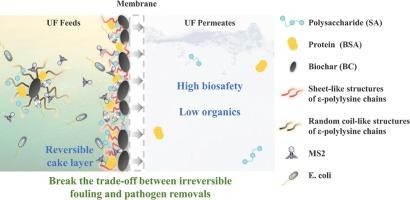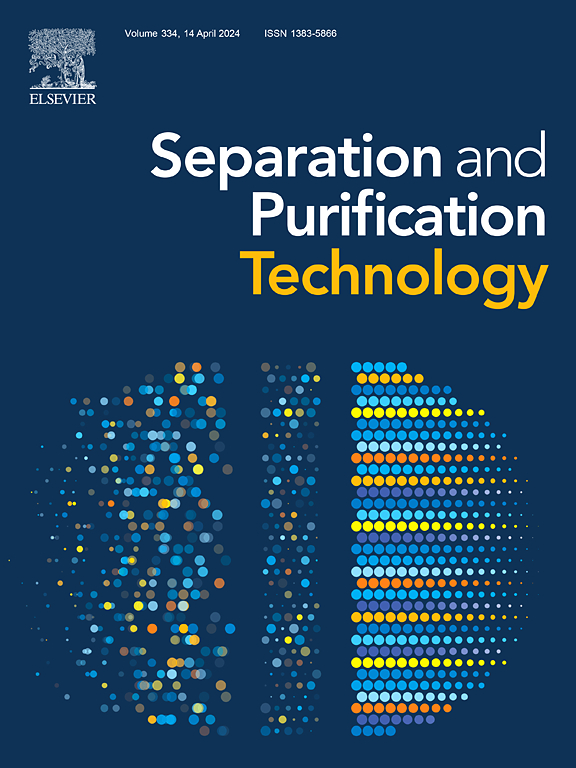Break through the trade-off between membrane fouling and pathogen removal in ultrafiltration process by poly(amino acid)s modified biochar
IF 8.1
1区 工程技术
Q1 ENGINEERING, CHEMICAL
引用次数: 0
Abstract
The fluctuation of pathogen removal in ultrafiltration (UF) systems and its dependence on irreversible fouling necessitates frequent chemical cleaning/disinfection, raising concerns about leakage of conditioned pathogens. An additional barrier utilizing carbon materials with notable adsorption and antimicrobial properties offers a promising and practical solution. This study achieved complete retention of nano-sized viruses (∼6 log reduction value (LRV)) and micron-sized bacteria (∼7 LRV) by introducing ε-polylysine (EPL)-modified biochar (BC) into UF feeds. During the UF process, biochar with superior adsorption capacities and conformational flexibility, significantly enhanced the entrapments of natural organic matter (NOM), viruses, and bacteria. Specially, EPL exhibited conformational transitions that adapted to different NOM (macromolecule proteins and linear polysaccharides), greatly facilitating the formation of reversible biochar-NOM cake layers and the transfer of pathogens from the irreversible fouling layer to the biochar surface and reversible fouling layer. The random coil structures of EPL promoted electrostatic attraction for virus particles, while bend or sheet-like structures created barriers for both bacteria and viruses through a refined NOM-biochar network. The trapping of viruses was attributed to the combined effects of electrostatic attraction, bonding forces, and the complex cake layers. And size exclusion by the biochar-NOM complex fouling layer played a prominent role in the retention of bacteria. This breakthrough in addressing the trade-off between irreversible fouling and pathogen removal inspires promising applications of EPL-modified biochar for UF systems to consolidate barriers for water and process biosafety. Future efforts should focus on EPL′s conformational response to protein-like NOM with significant steric hindrance, which pose challenges for fouling alleviation and bacteria capture.

利用聚(氨基酸)改性生物炭突破超滤过程中膜堵塞和病原体去除之间的权衡
由于超滤(UF)系统去除病原体的效果不稳定,而且依赖于不可逆的污垢,因此需要经常进行化学清洗/消毒,从而引发了对条件病原体泄漏的担忧。利用具有显著吸附和抗菌特性的碳材料作为额外的屏障,提供了一种前景广阔的实用解决方案。本研究通过在超滤进料中引入ε-聚赖氨酸(EPL)改性生物炭(BC),实现了纳米级病毒(降解值对数值∼6)和微米级细菌(降解值对数值∼7)的完全截留。在超滤过程中,生物炭具有卓越的吸附能力和构象灵活性,可显著提高天然有机物(NOM)、病毒和细菌的截留率。特别是 EPL 的构象转变适应了不同的 NOM(大分子蛋白质和线性多糖),极大地促进了可逆生物炭-NOM 饼层的形成,并将病原体从不可逆污垢层转移到生物炭表面和可逆污垢层。EPL 的随机线圈结构促进了对病毒颗粒的静电吸引,而弯曲或片状结构则通过精细的 NOM 生物炭网络为细菌和病毒创造了屏障。静电吸引、粘合力和复杂的滤饼层的共同作用使病毒被捕获。而生物炭-NOM 复合污垢层的尺寸排阻作用在细菌截留方面发挥了重要作用。在解决不可逆污垢和病原体去除之间的权衡问题上取得的这一突破,激发了 EPL 改性生物炭在超滤系统中的应用前景,从而巩固了水和工艺生物安全的屏障。未来的工作重点应放在 EPL 对具有明显立体阻碍的蛋白质类 NOM 的构象响应上,因为这些 NOM 对减轻污垢和细菌捕获构成了挑战。
本文章由计算机程序翻译,如有差异,请以英文原文为准。
求助全文
约1分钟内获得全文
求助全文
来源期刊

Separation and Purification Technology
工程技术-工程:化工
CiteScore
14.00
自引率
12.80%
发文量
2347
审稿时长
43 days
期刊介绍:
Separation and Purification Technology is a premier journal committed to sharing innovative methods for separation and purification in chemical and environmental engineering, encompassing both homogeneous solutions and heterogeneous mixtures. Our scope includes the separation and/or purification of liquids, vapors, and gases, as well as carbon capture and separation techniques. However, it's important to note that methods solely intended for analytical purposes are not within the scope of the journal. Additionally, disciplines such as soil science, polymer science, and metallurgy fall outside the purview of Separation and Purification Technology. Join us in advancing the field of separation and purification methods for sustainable solutions in chemical and environmental engineering.
 求助内容:
求助内容: 应助结果提醒方式:
应助结果提醒方式:


